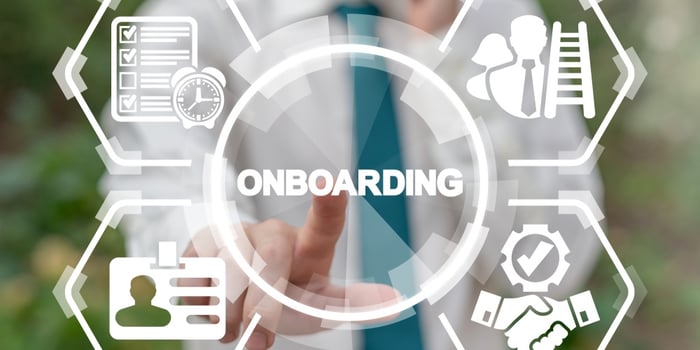
Most managers simplify job recruitment applications and interviewing processes to improve candidate experience. They, however, fail to invest in employee onboarding, which is an essential component of a successful hiring process. No matter how well you prepare to get employees, you must know what to do with them when they start to have the best impact.
Onboarding introduces new employees to your company's philosophies and acclimates them to new positions. Furthermore, it establishes trust and credibility between new employees and your organization while quickly training them to become productive. A well-thought-out strategy lets you highlight your expectations, create committed workers, and improve employee retention.
Let's discuss nine onboarding tips to get new employees productive quickly.
1. Building Onboarding Strategy Around Your Work Process
Typically, new employees are eager to understand the specifics of their job role and employer's expectations. Therefore, prepare documents with detailed information on your work policy, employee onboarding processes, and other relevant information for new hires to refer to as they learn and adjust to their role. You will present them with a lot of new information. Giving them resources to refer to as they process and develop that knowledge will lower their mistakes and build their confidence sooner.
You should consider several factors when building an onboarding strategy, such as:
- Concept: Think about what you intend to achieve and how you want to help through the onboarding process. Your mission statement should be your guiding premise.
- Roles and responsibilities: Clarify details regarding employee IDs, time-tracking, access permissions, and office materials, among other things.
- Process organization: Prepare a checklist for your HR and managers that highlights all the technical, social, and administrative responsibilities to ensure you omit nothing during the onboarding process.
- Automation: If possible, automate your employee onboarding process through HR software. Consider digital employee files or allocating tasks automatically.
Onboarding remote employees involve more documentation and automation. You can also include video chats and informal team meetings in your strategy. In addition, highlight the best channels your employees can use to ask questions or access information they might need, mainly if your time zones differ.
2. Assign New Hires a Mentor
A new employee needs a peer mentor who acts as a friendly face and a point person to approach if they need help. Mentors offer new hires a relaxed environment and help them adapt quickly. It provides new employees with consistent contact to ask any questions they may have. You also have someone to set the tone of your work culture and present an example for new hires to follow.
New positions can be overwhelming, especially if they require learning many new tasks, names, and faces. A mentor can provide reassurance by offering helpful feedback early on and removing any confusion about who they report to with any issues.
3. Organize Tools and Resources
Onboarding tools and resources help streamline the process for new hires and managers. Employee onboarding programs feature numerous activities that the workers must complete. In this case, you need to discover ways to manage these activities and enhance employee experience. Organize onboarding tools and resources, including:
- Chat systems: A unified resource that employees use to communicate with HR, such as to ask questions about benefits or request time off.
- Checklist: A list of onboarding activities, employees involved in the activities, and task timelines.
- Specialized tools: These simplify onboarding by providing communication tools, quiz builders, customizable checklists, paperwork digitization, and electronic onboarding to gather data for payroll processing.
- Integrated tools: These are all-purpose tools designed for managers handling onboarding-related tasks such as paperwork digitization.
Ensure that your employees have access to all the electronic files, software, or programs that they may require on time. Electronic onboarding helps your existing staff understand how to implement new employee orientation, making for a smoother transition by gathering all payroll data. New employees can focus better on learning their jobs when they can easily connect their bank account and email to payroll systems, and managers can hit the ground running with training. That way, the employees won’t have any wait times to get their direct deposits in order or need to worry about these essential tasks that don’t have much bearing on their daily responsibilities. It also lowers the stress of the company in getting this information together, while massively reducing the amount of paper they use when gathering personal data.
4. Create Weekly Itineraries for Employees to Follow
Depending on the week's agenda, prepare a schedule and assign tasks to your new employees. Ensure that they have a clear understanding of the onboarding process. Employees' capacity to visualize what to expect in the coming days improves their ability to be more productive and deliver as per your company's expectations. It also presents your company as a well-organized entity and does not leave them with too much free time.
Outline dates and times for training sessions, video calls, and other activities on an onboarding checklist. Having a well-planned program also offsets some of the decision-making needed early in a new role, letting them focus solely on their training tasks.
5. Standardize Your Training Process
You will achieve higher rates of new employee performance when you standardize your training process. In addition, everyone in your company will move in the same direction if you follow a consistent program. Standardized onboarding processes guarantee consistent employee training. New hires will also have a clear understanding of the company's goals and culture.
Keep in mind that different departments and roles will have individual tasks that cannot be specialized. However, there are core elements you can teach universally using the same handbook or internal video series. You can also arrange your strategy as a template, switching out and altering key components to provide specific guidance around each unique role.
6. Teach Your Culture
Company culture is vital to employee productivity success. It includes your organization's values and missions. Share your company's core values with the new hires from the beginning to help them understand the purpose and drive behind your daily activities. That act makes them feel like a part of your company's mission, and it develops a positive impression of your company early on.
Your culture connects your staff members with unified values, making them feel connected even if they don't work closely together. It also gives people meaning to their jobs beyond their work, which helps form a closer connection to the company. That dedication creates an intrinsic desire to perform well, assisting employees to be productive faster.
7. Arrange Meetings to Get to Know Current Employees
Involve as many team members as possible in the onboarding process. Ask the current employees to arrange meetings with the new employees and discuss various issues related to the company or a specific department. Also, give the new employee unlimited opportunities to ask questions that may guide the conversations. These meetings help new hires to connect with co-workers and feel welcome.
8. Tailor Training to Each Employee's Needs
Personalized training is crucial since each employee has unique responsibilities and learning styles. First, schedule a meeting with each employee and ask relevant questions to understand them better. Then slightly alter your onboarding process based on their preferred reinforcement mechanisms and best learning methods. For instance, you may find certain employees prefer learning visually, so instead of writing out guidelines to complete a task, you record a quick video going through the process. That will help your new employee learn their tasks better while also feeling better supported with their needs.
9. Emphasize Their Future at The Company
Refer to procedures and training with an infinite timeline. For instance, you can promise to offer them training to develop their careers in the future. Emphasizing employee future at your organization will make them feel welcome and inspire them to deliver exemplary results. Establishing early on that they have a future with the company gives them something to work towards and provides an open-ended investment in their future. High turnover lowers morale but maintaining a culture where your staff will grow with your company empowers employees to do their best.
Grow Your Business Faster with Better Onboarding
Effective onboarding helps new hires minimize stress, acclimate to their roles, and do their best. You will also benefit since your new employees become productive much earlier. Therefore, effective employee onboarding is a win-win!
The impact of modern onboarding practices on new employee productivity is immense. Creating and implementing the best employee onboarding strategy can be challenging. However, a PEO will help you develop an incredible onboarding process. They have the right mix of skills, ability, and experience; you can be confident that outsourcing HR professionals are rational. Let them handle the employees as you focus on growing your business.

